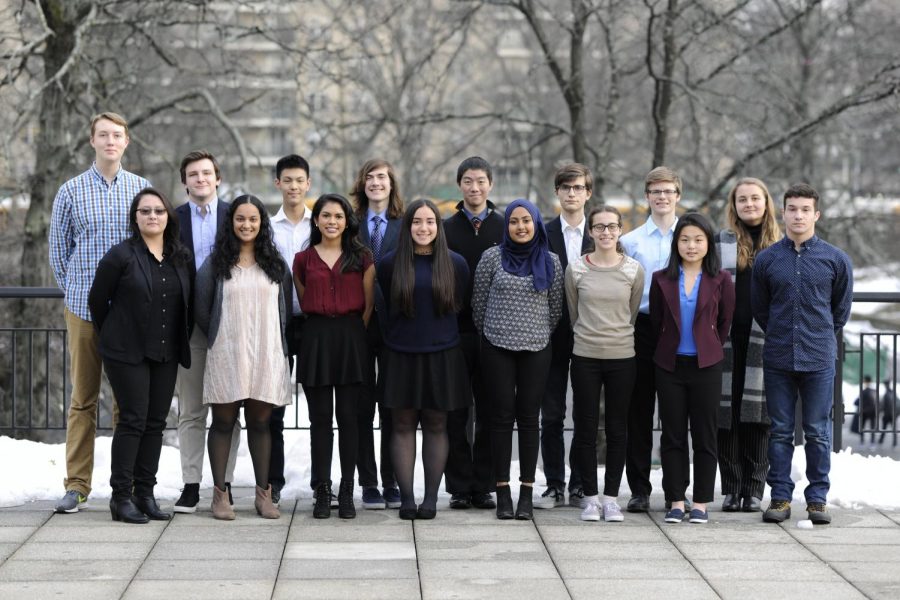Regeneron Names Seventeen from Science as Scholars
The 2018 Regeneron Science Talent Search Scholars.
On January 9, 2018, the new Bronx Science Regeneron Scholars were named, making history with 17 semifinalists.
Bronx Science students have competed in the Regeneron Science Talent Search for over seventy-five years. The competition, formerly known as the Intel Science Talent Search and originally known as the Westinghouse Science Talent Search, is an esteemed, nation-wide science competition in which students can submit original professional-level research. Since 1942, students at Bronx Science have had the opportunity to pursue their interests by completing research projects at labs belonging to prestigious institutions around the city. Following research tracks in math, biology, physical science, or social science, these projects are then submitted to receive awards and recognition.
“The skills that I have gained from this program are invaluable.”
This year’s Regeneron’s Top 300 Scholars are Alexa Asch, Philippe Baron, David Carter, Tainon Chen, Jennifer Cheung, Quincy Edwards, Nusrath Jahan, Swara Kalva, Mateo Massey, Ryoha Mitsuya, Max Porlein, Justin Qi, Theodore Sandler, Natasha Stamler, Jessica Su, Rachael Sue, and Vera Zarubin.
The results of the Regeneron STS were highly anticipated, as these students have been working on their research projects since their sophomore year. They started by reaching out to principal investigators and potential mentors at many different institutions. High schoolers are younger than most people who apply for positions at labs, making it even more difficult to find volunteer positions. Despite these circumstances, over one hundred Bronx Science students were able to find mentors and perform research.
This year, the researchers of the Class of 2018 made history on the national stage. Bronx Science students accounted for 5.6% of the 300 semi-finalists in a competition in which they made up about 0.1% of the applicant pool. With 6 more semi-finalists than the second top schools, Jericho Senior High School and Montgomery Blair High School, Bronx Science had the largest number of winners in the country. Additionally, with 231 STS Scholars since the program’s inception, Bronx Science has more semifinalists than any school in the history of the competition.
Despite our undoubtedly talented researchers in the program, the help of their mentors and teachers helped them to pull through. Mentors have supervised and guided our researchers since their first days in their labs. Nusrath Jahan ’18 researched the development of a pediatric tumor of the brainstem: Diffuse Intrinsic Pontine Glioma (DIPG). “I attribute most of my success to my mentor, Dr. Chul-Hwan Lee. He was always eager to teach the fundamentals of pursuing this topic and ensured that each step of the process was exciting. His willingness to help me learn about DIPG further stimulated my passion for research and neuroscience. Without his assistance, I would have never been able to accomplish all that I did!” said Jahan.
Our faculty has also contributed greatly to the research projects. Students and teachers have the opportunity to work together to hone the projects. In classroom settings, the teachers and students have worked closely together for two years or more. “Small groups are essential because of the time required to work individually with each student,” said Biology Research teacher Mr. Richard Lee.
The collaborative efforts of students, teachers, and mentors make Bronx Science’s research program uniquely remarkable. Awards aside, being able to develop and conduct an independent study as a high school student is a rare and rewarding experience. “The skills that I have gained from this program are invaluable. The mindset of ‘success is doing better than you expected’ is one that I have learned through the research program. The people whom I’ve met are now my strongest network of support. It is a wonderful environment that pushes me to the best version of myself,” said Jennifer Cheung ’18.
Maggie Wong is a sidebar and captions editor for ‘The Observatory’ and a Staff Reporter for ‘The Science Survey.’ Journalism first became an interest...

